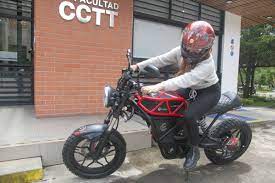Electric motorcycle, the beginning of the dream to create an assembly plant in Cuenca

An electric motorcycle was made by students and teachers from the University of Azuay (UDA), with the vision of creating an assembly plant in Cuenca.
Andrés López, dean of the Faculty of Science and Technology of the UDA, explained that the project is financed by the Ecuadorian Corporation for the Development of Research and Academia (CEDIA) and the company TRATURAL, the latter focused on support energy ventures.
The university contributed with the prototype, framed in a complete feasibility study to promote an assembly plant. “We carry out all the studies with a team of more than 20 professionals,” López explained.
The contribution was from the Automotive Engineering school, as well as representatives from the Object Design, Production Engineering and Commercial Engineering careers.
Features
Robert Rockwood, coordinator of the School of Automotive Engineering, explained that structural topology optimization techniques were used for the mechanical design of the chassis, defining the ideal shape for better efficiency. “This means that it has the best structural features at the lowest weight, with the restriction that the manufacturing process is at the technological level of our environment. In other words, the project of serial manufacturing of the chassis is technologically viable”, Rockwood referred.
The chassis of this electric motorcycle has all the safety standards required by the automotive industry. The calculations, analysis and computational simulation of the mechanical performance were made, guaranteeing the functionality and safety of the occupants.
Within the electronic programming of the control module, the aim is to optimize the use of energy to achieve maximum autonomy, without reducing the dynamic performance of the motorcycle - acceleration capacity and maximum speed.
Rockwood stressed that the manufactured prototype has excellent dynamic performance, good maneuverability, acceleration capacity and top speed, allowing it to compete with motorcycles intended for urban or highway use.
After the respective tests of this prototype, with normal handling a range of 70 km per battery charge is achieved. “This could improve if the bike is dedicated to a particular function. For example: if it is used to carry out a delivery service, it can be programmed so that it has a lower acceleration capacity, increasing the autonomy of up to 100 km”, said Rockwood.
The current conception is an urban motorcycle, but it can be adapted to different styles and functions. With the incorporation of modules, it can be a delivery motorcycle or for Civil Traffic Agents.
Charge
This prototype can be charged in a common outlet, with a standard supply of electricity (110v), in a time of four hours. Another option is to purchase a larger capacity charger to cut charging time in half. The batteries are lithium ion.
By using a source of electrical energy, it contributes to reducing fossil fuel emissions, being an alternative to climate change. "Oil will one day run out, while electricity can be generated sustainably," he detailed.
The supply of its components (spare parts) is guaranteed.
Electric vehicles
López and Rockwood agreed that the trend is to promote electric vehicles worldwide. According to the National Energy Efficiency Law, it is expected that by 2025 all the buses that are incorporated will be electric.
In Europe and several countries there are maximum production dates for vehicles with internal combustion engines.

